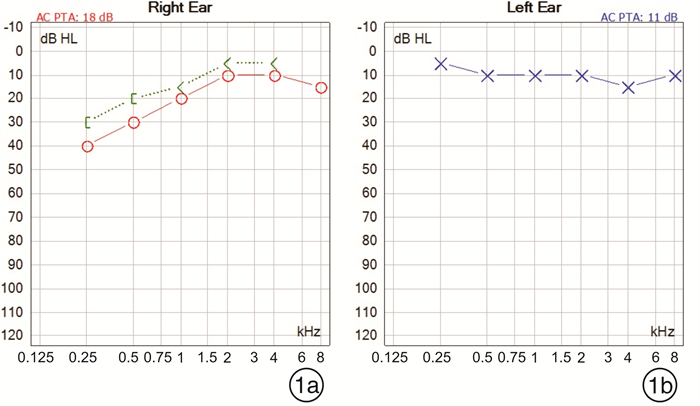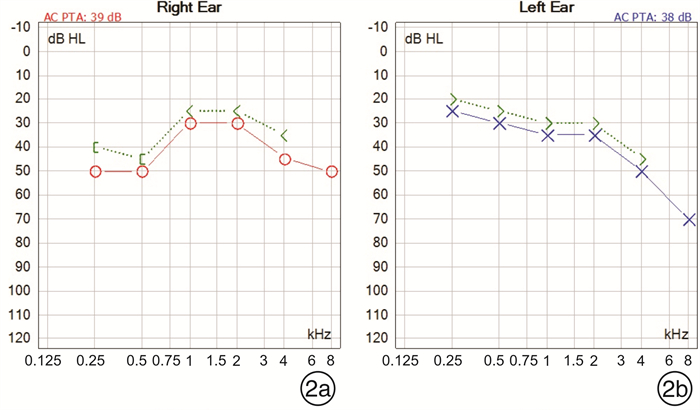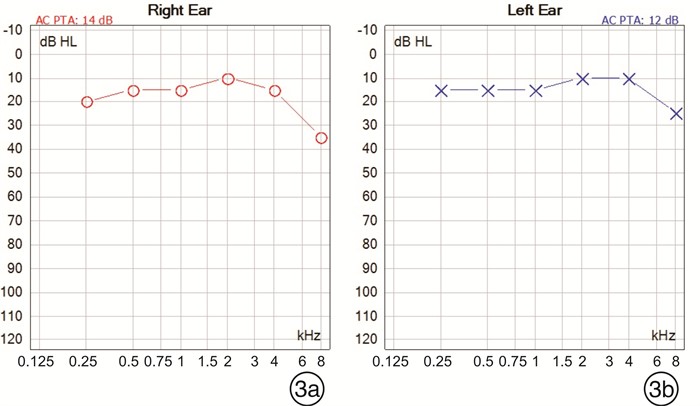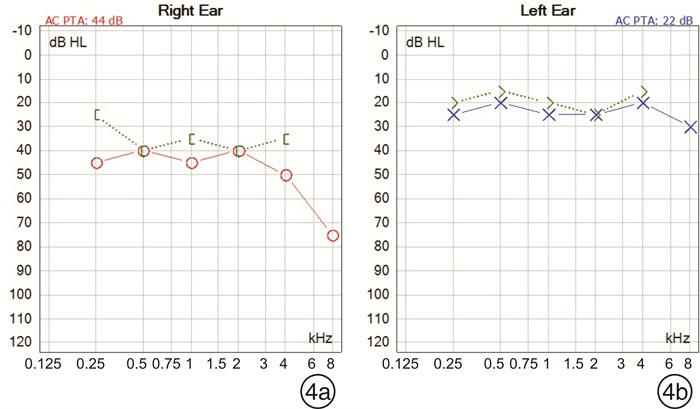-
摘要: 目的 分析耳蜗型偏头痛的临床特征。方法 收集87例耳蜗型偏头痛患者的临床资料, 对其临床症状和听力检查结果进行分析。结果 耳蜗型偏头痛患者的男女比例为1:3.1;30~60岁是发病高峰; 临床症状有耳鸣61例(70%)、轻度听力下降52例(60%)、耳闷13例(15%)、听觉过敏9例(10%)和耳痛5例(6%); 61.5%(32/52)的听力下降患者表现为高频轻度神经性聋, 34.6%(18/52)的患者表现为低频轻度神经性聋, 3.8%(2/52)的患者表现为全频轻度神经性聋。经抗偏头痛治疗, 耳鸣、听力下降、耳闷、听觉过敏、耳痛的有效率分别为57.4%、71.2%、69.2%、66.7%和60.0%。结论 对耳蜗型偏头痛临床特点的总结, 为内耳疾病的抗偏头痛治疗方案介入提供了依据。Abstract: Objective The aim of this study is to analyze the clinical features of cochlear migraine.Methods The clinical data of cases of cochlear migraine were collected, and the clinical symptoms and hearing examination results were analyzed.Results The ratio of male to female patients with cochlear migraine was 1:3.1; the peak incidence was between 30 to 60 years old; the clinical symptoms were tinnitus in 61 people(70%), mild hearing loss in 52 people(60%), aural fullness in hyperacusis in 13 people(15%), auditory allergy in 9 people(10%) and otalgia in 5 people(6%); the audiology characteristic was that 61.5%(32/52) of patients with hearing loss showed mild high-frequency neurological hearing loss, 34.6%(18/52) of patients showed mild low-frequency neurological hearing loss, and 3.8%(2/52) of patients showed full-frequency mild neurological hearing loss; the effective rate of tinnitus treatment was 57.4%, the effective rate of hearing loss was 71.2%, and the effective rate of aural fullness was 69.2%, the effective rate of hyperacusis is 66.7% and the effective rate of otalgia is 60.0%.Conclusion The clinical characteristics of cochlear migraine are summarized, which provides a basis for the intervention of anti-migraine treatment programs for inner ear diseases.
-
Key words:
- cochlear migraine /
- tinnitus /
- deafness /
- aural fullness /
- hyperacusis
-

-
表 1 偏头痛体质表
症状(每项1分) 得分 1.晕动病家族史:家里亲属有人晕车 2.偏头痛家族史:家里直系亲属头痛 3.反复头晕家族史:家里直系亲属反复头晕病史 4.声音敏感:特别怕大的声音,手机铃声都很小 5.光线敏感:怕闪光灯,手机屏幕不能太亮 6.气味敏感:对香水味等特别敏感 7.天气变化敏感:阴天和晴天感觉不同 8.视动敏感:比如看理发店外面旋转的条难受 9.头动敏感:快速反复转头时感觉头晕 10.药物敏感:很低剂量的药物就可能引起过敏 11.痛觉敏感:慢性疼痛病史,鼻源性头痛病史,反复颈部僵硬不适 12.肠易激综合征:对特定的食物敏感,容易拉肚子或容易便秘 13.胃食管反流:反酸打嗝烧心 14.其他肠道功能性疾病:如溃疡性结肠炎 15.血管运动性鼻炎:常年遇到冷热空气喷嚏,流涕无明确过敏原 16.变应性鼻炎:有明确过敏原 合计 表 2 耳蜗型偏头痛的临床症状和性别分布
例 性别 耳鸣 轻度听力下降 耳闷 听觉过敏 耳痛 头痛 男 14 11 4 3 1 9 女 47 41 9 6 4 22 合计 61 52 13 9 5 31 表 3 耳蜗型偏头痛患者的纯音听力结果
例 性别 低频轻度
神经性聋高频轻度
神经性聋全频轻度
神经性聋合计 单侧 双侧 单侧 双侧 单侧 双侧 男 2 1 0 6 0 0 9 女 12 3 18 8 0 2 43 合计 14 4 18 14 0 2 52 表 4 抗偏头痛治疗方案的疗效
例数 痊愈 好转 有效 无效 有效率/% 耳鸣 61 6 18 11 26 57.4 听力下降 52 19 12 6 15 71.2 耳闷 13 4 3 2 4 69.2 听觉过敏 9 2 1 3 3 66.7 耳痛 5 1 1 1 2 60.0 -
[1] Hwang JH, Tsai SJ, Liu TC. Association of Tinnitus and Other Cochlear Disorders With a History of Migraines[J]. JAMA Otolaryngol Head Neck Surg, 2018, 144(8): 712-717. doi: 10.1001/jamaoto.2018.0939
[2] Hamed SA, Youssef AH, Elattar AM. Assessment of cochlear and auditory pathways in patients with migraine[J]. Am J Otolaryngol, 2012, 33(4): 385-394. doi: 10.1016/j.amjoto.2011.10.008
[3] 赖仁淙, 刘琼临. 内耳型偏头痛: 前庭性偏头痛与耳蜗性偏头痛[J]. 临床耳鼻咽喉头颈外科杂志, 2019, 33(3): 200-204. https://www.cnki.com.cn/Article/CJFDTOTAL-LCEH201903003.htm
[4] Lai JT, Liu TC. Proposal for a New Diagnosis for Cochlear Migraine[J]. JAMA Otolaryngol Head Neck Surg, 2018, 144(3): 185-186. doi: 10.1001/jamaoto.2017.2427
[5] Moshtaghi O, Ghavami Y, Mahboubi H. Migraine-Related Aural Fullness: A Potential Clinical Entity[J]. Otolaryngol Head Neck Surg, 2018, 158(1): 100-102. doi: 10.1177/0194599817739255
[6] Teixido M, Seymour P, Kung B, et al. Otalgia associated with migraine[J]. Otol Neurotol, 2011, 32(2): 322-325. doi: 10.1097/MAO.0b013e318200a0c4
[7] 余力生. 特发性耳鸣诊疗思路[J]. 临床耳鼻咽喉头颈外科杂志, 2014, 28(4): 219-221. https://www.cnki.com.cn/Article/CJFDTOTAL-LCEH201404002.htm
[8] Neff BA, Staab JP, Eggers SD. Auditory and vestibular symptoms and chronic subjective dizziness in patients with Ménière's disease, vestibular migraine, and Ménière's disease with concomitant vestibular migraine[J]. Otol Neurotol, 2012, 33(7): 1235-1244. doi: 10.1097/MAO.0b013e31825d644a
[9] 中国医师协会神经内科医师分会疼痛和感觉障碍学组、中国医药教育协会眩晕专业委员会、中国研究型医院学会头痛与感觉障碍专业委员会. 前庭性偏头痛诊治专家共识(2018)[J]. 中国疼痛医学杂志, 2018, 24(7): 481-488. doi: 10.3969/j.issn.1006-9852.2018.07.001
[10] 巩丽娜, 于栋祯, 殷善开. 前庭性偏头痛研究进展[J]. 临床耳鼻咽喉头颈外科杂志, 2018, 32(15): 1143-1147. https://www.cnki.com.cn/Article/CJFDTOTAL-LCEH201815006.htm
[11] Chu CH, Liu CJ, Fuh JL. Migraine is a risk factor for sudden sensorineural hearing loss: a nationwide population-based study[J]. Cephalalgia, 2013, 33(2): 80-86. doi: 10.1177/0333102412468671
[12] Radtke A, von Brevern M, Neuhauser H. Vestibular migraine: long-term follow-up of clinical symptoms and vestibulo-cochlear findings[J]. Neurology, 2012, 79(15): 1607-1614. doi: 10.1212/WNL.0b013e31826e264f
[13] Ray J, Carr SD, Popli G. An epidemiological study to investigate the relationship between Meniere's disease and migraine[J]. Clin Otolaryngol, 2016, 41(6): 707-710. doi: 10.1111/coa.12608
[14] Kim SY, Kim MK, Lim JS. Migraine increases the proportion of sudden sensorineural hearing loss: A longitudinal follow-up study[J]. Auris Nasus Larynx, 2019, 46(3): 353-359. doi: 10.1016/j.anl.2018.10.006
-

| 引用本文: | 谢存存, 牛文侠, 丁韶洸, 等. 87例耳蜗型偏头痛患者的临床特征分析[J]. 临床耳鼻咽喉头颈外科杂志, 2021, 35(2): 112-115. doi: 10.13201/j.issn.2096-7993.2021.02.005 |
| Citation: | XIE Cuncun, NIU Wenxia, DING Shaoguang, et al. Analysis of clinical characteristics of 87 patients with cochlear migraine[J]. J Clin Otorhinolaryngol Head Neck Surg, 2021, 35(2): 112-115. doi: 10.13201/j.issn.2096-7993.2021.02.005 |
- Figure 1.
- Figure 2.
- Figure 3.
- Figure 4.




 下载:
下载:


